Third-Generation (3G) Mobile
A status report
Since mobile cellular became commercially available in the early
1980s, it has advanced beyond imagination in terms of coverage, services,
technology, handsets and regulation. Perhaps the most revolutionary change is
that in the space of around 20 years, mobile subscribers surpassed
fixed-telephone line subscribers in 2002, making mobile technology the
predominant means of voice communications (see Figure 1, left chart).
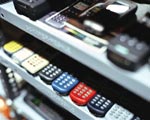
A collection tracking the history of mobile
communications
ITU 030082/Siemens AG
|
First generation mobile cellular networks employed analogue
technology. Developments in digital technology led to second-generation (2G)
systems. By the end of the 1980s, 2G networks had been developed to provide
better quality services, greater capacity and additional functionality than
analogue systems. At the end of 2002, the world had almost completed the
transition to digital cellular networks, with analogue users accounting for a
mere three per cent of total mobile subscribers. There are four 2G digital
cellular radio technologies in use around the world (see Figure
1, right chart):
1
1 The Personal Handyphone System (PHS) is a digital system
launched in Japan in 1995. As a low-cost alternative to cellular, it has limited
coverage area. There were 5.6 million PHS subscribers, all in Japan, at December
2002.
-
Global System for Mobile Communications
(GSM). This is
the predominant technology worldwide and the predominant system in Europe. It is
also used in many nations in Africa, Asia, the Middle East and some countries in
the Americas. At December 2002, there were 788 million GSM subscribers on 467
networks in 169 countries.
-
Time Division Multiple Access (TDMA).
This is the
leading technology in the Americas with 109 million subscribers at December
2002.
-
Code Division Multiple Access (CDMA). At December 2002,
there were 147 million CDMA subscribers with 61 per cent in the Americas, 37 per
cent in the Asia-Pacific region and less than two per cent in Europe, the Middle
East and Africa.
-
Personal Digital Cellular (PDC). This system is
deployed only in Japan with 60 million subscribers at December 2002.
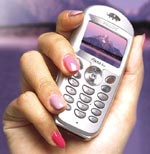
New generation liquid-crystal display (LCD) mobile phone
ITU 030084/Philips
|
A significant development with 2G systems has been the
increasing utilization of data-like services, for example, the short message
service (SMS), which allows text messages to be sent between mobile handsets.
Some 360 billion SMS were sent over GSM networks in 2002.2 Mobile handsets are
also increasingly being used to access the Internet. This has become successful
in countries such as Japan, where 80 per cent of cellular users subscribe to a
mobile Internet service provider.3 The growing use of mobile data has led to
demand for faster speed than the initial transmission rate of 9.6 kbit/s for GSM.
This is being accomplished by upgrading existing GSM networks with the
deployment of General Packet Radio Service (GPRS) technology. In the case of
cdmaOne networks, they are being enhanced with CDMA2000 1X technology. These
technologies offer speeds that are equivalent to, or even faster than,
conventional dial-up.
2
See “GSM Statistics” on the GSM Association website at
www.gsmworld.com/news/statistics/index.shtml
3 See the “Internet Provider Services (Mobile Telephone)”
section of the “Number of Subscribers” report issued monthly by the
Telecommunication Carriers Association (TCA) of Japan. In December 2002, TCA
reported that there were 59.5 million subscribers to the mobile Internet
services known as i-mode (provided by the NTT DoCoMo Group), Ezweb (provided by
the au Group and the Tu-Ka Group) and J-sky (provided by J-Phone). This is out
of a total of 73.5 mobile telephone subscribers (see www.tca.or.jp/eng/database/daisu/yymm/0212matu.html).
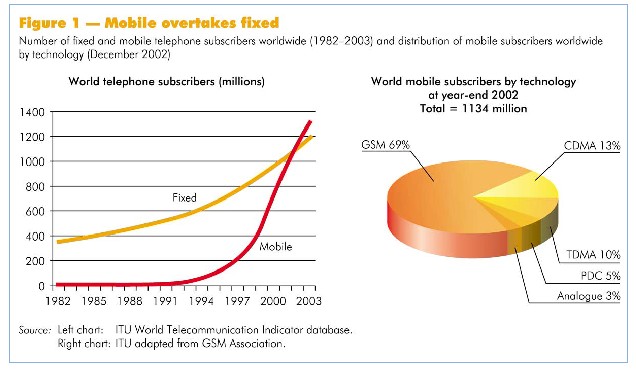
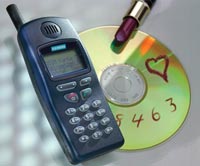 A dual-band mobile phone of 1999. Its simple menu
and large display appealed to first-timers, especially youth. With the
young target group came music too A dual-band mobile phone of 1999. Its simple menu
and large display appealed to first-timers, especially youth. With the
young target group came music too
ITU 030083/Siemens AG
|
The development of 3G systems
The need for faster speed, global compatibility and multimedia
services has led to the development of 3G systems. In an effort to consolidate
existing incompatible mobile environments into a seamless global network, ITU
adopted a family of radio access methods at its Radiocommunication Assembly in
Istanbul in early May 2000. Known as International Mobile
Telecommunications-2000 (IMT-2000), this global standard was realized after
years of collaborative work between ITU and the global cellular community. At
the end of May 2000, the World Radiocommunication Conference (also held in
Istanbul) identified additional frequency bands for 3G (IMT-2000) use.4
IMT-2000 consists of five different radio access methods: W-CDMA (Wideband Code Division
Multiple Access), CDMA20001X, TD-SCDMA, EDGE (Enhanced Data Rates for GSM
Evolution) and DECT (Digitally Enhanced Cordless Telecommunications).
4 See ITU Press releases: “ITU gives final approval to
IMT-2000 radio interface specifications” (8 May 2000) at www.itu.int/newsarchive/press_releases/2000/10.html
and: “Thumbs up for IMT-2000” (30 May 2000) at www.itu.int/newsarchive/press_releases/2000/12.html

|
An innovative mobile phone with a built-in
rotating camera and colour screen, to be released in the GSM market in
2003
ITU 030088/Samsung
|
The evolutionary path from 2G to 3G has been mapped out for
existing networks (see Figure 2). Migration differs depending on the existing 2G
network. In general, W-CDMA would require a brand new network to be installed
whereas CDMA2000 1X requires less investment as an upgrade from existing
second-generation CDMA networks. Among the five radio access technologies
approved as IMT-2000, W-CDMA and CDMA2000 1X have gained the most support from
regulators, mobile network operators and equipment manufacturers.
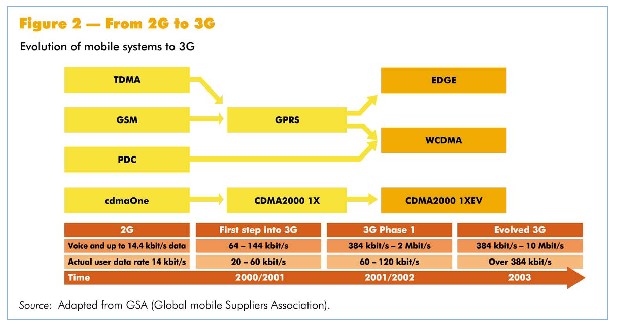
At the end of 2002, there were 119 licences that had been
awarded to operators around the world for the use of IMT-2000 spectrum to offer
3G mobile services. An important consideration in the 3G licensing process is
exactly what is being offered. In most countries, the licensing includes the
needed spectrum, typically in the 2 GHz range. In some cases, particularly most
of Europe, the 3G radio interface was also specified. In other cases, there was
no explicit requirement for a specific radio interface as long as it was one
identified in the IMT-2000 standard. While auctions and beauty contests have
been the preferred licence allocation methods, some countries have automatically
granted 3G licences to incumbents. For example in Europe, 3G licences were
offered free of charge to the incumbent mobile operators in the Isle of Man,
Liechtenstein and Monaco.
The optimum method of allocating licences is subject to debate.
Proponents of auctions will argue that frequency is a scarce resource and its
pricing should be left to the market. Backers of beauty contests will argue that
their method avoids high auction prices that will eventually be passed on to
consumers. There are also political aspects since, in some instances, the
licence fees revert to the government budget.
Auction
In this method of licence allocation, a frequency range
identified for the use of 3G networks is auctioned. A number of licences are
made available depending on spectrum and market conditions. Successful
applicants are those that outbid others.
There has been great variation in the relative price paid for 3G
licences that have been auctioned. The average price per capita in Germany and
the United Kingdom amounted to EUR 615 and 644 respectively. In contrast,
Austria and Denmark collected an average licence price per capita of EUR 103
and 95. One reason is timing. Germany and the United Kingdom were among the
first to auction 3G licences. Euphoria was high, as were the prices. It is
possible that licences will be sold at or near their reserve price (i.e.,
minimum bid price) when the number of bidders is the same or less than the
number of licences available. Such was the outcome when Switzerland conducted
its auction in December 2000. Auctions can also be cancelled under such
circumstances, as was the case in Singapore and Slovenia where the bidders
simply paid the reserve price. In total, 77 licences for 3G have been granted in
19 economies via auctions, accounting for USD 101 billion (see Table
1).
Beauty contest
In a beauty contest, a fixed number of licences are awarded to
applicants that best meet certain criteria. The regulator issues an invitation
to all interested parties with guidelines and requirements. Successful
applicants are chosen based on specific pre-determined criteria presented in the
application. The selection criteria differ from country to country, depending on
the respective plans and objectives in establishing a 3G network. In general,
applicants are evaluated based on their financial capacity, business plan and
technical expertise. Criteria that are often used are commitments to rapid
roll-out and with high levels of land and population coverage. Other aspects
such as market concentration and technological specifications are also taken
into consideration.
Like a real beauty pageant, applicants are awarded points for
satisfying the specific criteria stipulated. Applicants with the highest scores
are awarded licences. Normally, licensees also pay a fixed licence fee, but some
countries, like Japan and Finland, waived this fee. In this method, licence
costs are significantly lower than the auctioned licences, yet France and Poland
were noteworthy for having high fees.
Some 41 3G licences have been issued in 13 countries via beauty
contests accounting for USD 6.9 billion (see Table 2).

A mobile handset using EDGE technology
as
an initial phase to launching further broadband applications in Malaysia
ITU 030080/Siemens AG
|
Regional analysis
Universal Mobile Telecommunications System (UMTS) is the term
Europe uses to refer to 3G networks. It maps out the migration path for GSM
networks to 3G. UMTS uses the IMT-2000 W-CDMA radio interface in the frequency
bands 1900—1980 MHz, 2010—2025 MHz and 2110—2170 MHz. In December 1998, the
European Parliament mandated that all European Union (EU) member countries adopt
UMTS. The decision imposed a specific timetable for UMTS, including a deadline
for licensing by 1 January 2000 and introduction of commercial services by 1
January 2002. All EU members had completed the 3G licensing process by May 2002.
Non-EU countries in Western Europe such as Norway and Switzerland have also
completed the 3G licensing process. In Central and Eastern Europe, the Czech
Republic, Latvia, Poland, the Slovak Republic and Slovenia have licensed 3G
operators. By 31 December 2002, some 26 countries and territories in Europe had
completed 3G licensing processes.
In the Asia region, economies such as Hong Kong, China; Israel,
Japan, the Republic of Korea, Malaysia, Singapore and Taiwan, China had issued
23 licences for 3G by December 2002.
In the Oceania region, Australia and New Zealand have allocated
spectrum and awarded licences for 3G.
Canada is the only country from the Americas region that has
auctioned 3G spectrum in the 2 GHz range. Several countries in the Americas have
already allocated licences for so-called Personal Communications Services (PCS)
that take up parts of the spectrum bands identified for 3G services. There are
several factors holding back the allocation of additional spectrum for 3G in the
region. One is that local operators have already invested heavily in building
their 2G networks (in the 1900 MHz band). Additional spectrum would require more
investments which operators are presently unable or unwilling to make. Another
factor is the plurality of different systems in the region (i.e., TDMA, GSM and
CDMA), which complicates the migration path from 2G to 3G.
Table 1 — Outcome of 3G mobile licence auctions
Status at 31 December 2002
| |
Economy |
Auction
date |
Number
of winners |
Amount
(USD million) |
Remarks |
| 1 |
United
Kingdom |
April
2000 |
5 |
35
411 |
The four incumbents were
awarded licences plus a new entrant |
| 2 |
Netherlands |
July
2000 |
5 |
2515 |
All five incumbents won the
licences |
| 3 |
Germany |
August
2000 |
6 |
46
323 |
Four incumbents won licences |
| 4 |
Italy |
October
2000 |
5 |
10
084 |
Three of four incumbents won
licences |
| 5 |
Austria |
November
2000 |
6 |
716 |
All six bidders won licences,
including the four incumbents |
| 6 |
Switzerland |
December
2000 |
4 |
121 |
Four bids for four licences |
| 7 |
New
Zealand |
January
2001 |
5 |
60 |
Four licences were awarded
at auction and a fifth was set aside for the Maori people |
| 8 |
Canada |
February
2001 |
5 |
931 |
Five bidders won 52 regional
licences |
| 9 |
Belgium |
March
2001 |
3 |
418 |
Three bids received for four
licences on offer |
| 10 |
Australia |
March
2001 |
6 |
578 |
Two national and various
regional licences were awarded to six bidders |
| 11 |
Singapore |
April
2001 |
3 |
166 |
Auction cancelled since
there was the same number of bids as licences to be awarded. Each
licence was awarded for the reserve price |
| 12 |
Greece |
July
2001 |
3 |
414 |
Four licences had been on
offer. The three incumbents were awarded licences |
| 13 |
Hong
Kong, China |
September
2001 |
4 |
671 |
Bidders had to pre-qualify.
Only four bidders for four licences. Amount equals bid plus minimum
royalty payments for 15 years |
| 14 |
Denmark |
October
2001 |
4 |
496 |
Sealed bid where licence
price corresponded to the fourth highest bid in the auction |
| 15 |
Slovenia |
November
2001 |
1 |
90 |
Licence awarded to only
bidder (three licences had been offered) |
| 16 |
Czech
Republic |
December
2001 |
2 |
203 |
Two incumbents won with the
third not participating |
| 17 |
Israel |
December
2001 |
3 |
157 |
Won by the three incumbents |
| 18 |
Taiwan,
China |
February
2002 |
5 |
1397 |
Only three of six incumbents
won licences |
| 19 |
Latvia |
October
2002 |
2 |
19 |
Two incumbents bid for three
licences |
| |
Total |
|
77 |
100 771 |
|
Table 2 — Outcome of 3G mobile licence beauty contests
Status at 31 December 2002
| |
Country |
Date
licence awarded |
Number
of licences |
Amount
(USD million) |
Remarks |
| 1 |
Finland |
March
1999 |
4 |
– |
Administrative fee of EUR
1000 per 25 kHz |
| 2 |
Spain |
March
2000 |
4 |
444 |
Amount does not include
yearly radio spectrum fees |
| 3 |
Japan |
June
2000 |
3 |
– |
Two W-CDMA and one CDMA2000
1X |
| 4 |
Norway |
December
2000 |
3 |
45 |
In addition, each licensee
is expected to pay USD 2.2 million per year as frequency usage charge |
| 5 |
Portugal |
December
2000 |
4 |
360 |
Not including annual
spectrum fee |
| 6 |
Poland |
December
2000 |
3 |
1839 |
Awarded to three incumbents |
| 7 |
Korea
(Republic of) |
December
2000
August 2001 |
3 |
2886 |
KTF and SK Telecom awarded
W-CDMA licences followed by LG Telecom (CDMA2000 1X) |
| 8 |
Sweden |
December
2000 |
4 |
– |
Spectrum use fee and 0.15
per cent of turnover |
| 9 |
France |
July
2001
May 2002 |
3 |
1042 |
Bouygues Telecom was awarded
a 3G licence, at a lower price, after the two incumbents, France Telecom
and SFR |
| 10 |
Luxembourg |
May
2002 |
3 |
– |
Annual spectrum usage fee of
0.2 per cent of turnover or a minimum of EUR 200 000 |
| 11 |
Ireland |
June
2002 |
3 |
173 |
Two incumbents awarded
licence plus new entrant |
| 12 |
Slovakia |
June
2002 |
2 |
67 |
Three licences had been
awarded but one was later withdrawn |
| 13 |
Malaysia |
July
2002 |
2 |
26 |
Additional maintenance fees
based on the number of transmitters set up in each licensee’s 3G
network |
| |
Total |
|
41
|
6882
|
|
Table 3 — Regional distribution of 3G licences and deployments
Status at 31 December 2002
| 3G
licences1 |
CDMA2000
1x2 |
Total |
| Region |
Number of countries |
Number of licences |
Licence fees (USD million) |
Number of country launches |
Number of operator launches |
Number of country launches |
Number of operator launches |
Number of countries |
Number of launches |
| Africa |
– |
– |
– |
– |
– |
– |
– |
– |
– |
| Americas |
1 |
3 |
931 |
– |
– |
9 |
20 |
9 |
20 |
| Asia |
7 |
23 |
4310 |
1 |
3 |
3 |
5 |
4 |
8 |
| Europe |
26 |
83 |
100 588 |
3 |
4 |
3 |
3 |
6 |
7 |
| Oceania |
2 |
10 |
673 |
– |
– |
2 |
2 |
2 |
2 |
| Total |
36 |
119 |
106 502 |
4 |
7 |
17 |
30 |
21 |
37 |
1 Where there was a formal 3G licence process.
2 Launched as an extension of existing networks.
Source: ITU.

A 1992 mobile phone — a model that was
especially popular with architects, construction site managers and
surveyors
ITU 030090/Siemens AG
|
In some countries, spectrum in the IMT-2000 bands cannot be made
available as it is used for national security purposes. Finally, existing
spectrum bands (1850–1990 MHz) can be used to provide 3G-type services and
operators in the region with CDMA networks are choosing to evolve to CDMA2000 1X
(recognized as an IMT-2000 standard) without the need for additional spectrum.
No African country has issued licences for IMT-2000. In most
African countries, there are already many more mobile than fixed telephone
subscribers, so 3G could be a key technology for enhancing Internet penetration
in the region. While no formal IMT-2000 licensing has taken place, it could be
that operators in some African countries may introduce 3G-like services within
existing frequency allocations. These include fixed wireless operators using
CDMA that hope to introduce a mobility mode. For example, a Nigerian
telecommunication operator has announced plans to launch a CDMA2000 1X network.5
5 See Ericsson’s Press release of 2 April 2003: “Ericsson
and Nigeria’s RelTel Sign CDMA2000 1X” (www.ericsson.com/press/20030402-083853.html).
The rotating camera phone
ITU 030091/Samsung
Roll-out of 3G networks is in theory guided by timetables stated
in the licence conditions such as required minimum coverage by a specified date.
However, market demand and handset availability have impacted deployment
schedules and many networks have been delayed.
In Asia, SK Telecom of the Republic of Korea launched its CDMA
2000 1X network in October 2000.6 Japan’s NTT DoCoMo pioneered the deployment
of W-CDMA, launching its 3G service commercially in October 2001.
6
See “SK Telecom Launches Commercial cdma 2000 1x Service”,
Press release of 30 September 2000 (www.sktelecom.co.kr/english/newspr/news/2002/06/01/219,1012,0,0,0.html). SK Telecom was awarded a 3G licence but
for a network using W-CDMA technology. Republic of Korea mobile operators
consider CDMA2000 1X to be a 2.5G network. For example, LG Telecom, a Republic
of Korea mobile operator states on its website that “CDMA2000 1X is a 2.5
generation Mobile Communication Service” (see (www.lg019.co.kr/docs/eng/imt/imtcdma01.jsp).
In Europe, commercial 3G services based on W-CDMA were not
available by 1 January 2002, as had been called for in the EU guidelines.
Nascent 3G networks established in Austria, Finland, the Isle of Man and Monaco
initially provided trial services.
Manx Telecom, on the Isle of Man launched Europe’s first 3G
network in December 2001, and services became commercially available in July
2002. Although Finland was the first country in the world to license 3G, and
incumbent operator Sonera met licensing conditions by having its network
available on 1 January 2002, commercial service was not available until
September due to lack of handsets. Austria’s Mobilkom launched its 3G network
on 25 September 2002. In March 2003, Hutchison commercially launched 3G services
in the United Kingdom and Italy, as well as in Australia in April and in Sweden
in May.
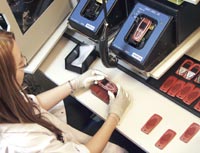
Mobile phone production:
The final testing of a handset
ITU 030089/Nokia
|
Overall, uptake of 3G services based on W-CDMA has been slower
than initially announced. Handset availability and network interoperability have
been cited as reasons for the sluggish 3G market. Low market interest has
further exacerbated this scenario. The only other W-CDMA launches have been in
Japan, where in addition to NTT DoCoMo, J-Phone launched a W-CDMA network in
December 2002. These two operators had a combined 153 200 3G subscribers at
year-end 2002.
The use of CDMA2000 1X in existing mobile frequencies as an IMT-2000
standard has led to more rapid launches. Except for Japan, all CDMA2000
1X networks have been launched without the need for a new licence as they
operate in existing licensed radio frequencies. By the end of December 2002,
there had been 30 commercial CDMA2000 1X launches in 17 countries.7 The number
of CDMA2000 1X subscribers at December 2002 was 32.6 million with the vast
majority in the Republic of Korea and Japan.
7 See the “Operators” section of the 3G Today website for
updated listings of commercial CDMA2000 1X launches (www.3gtoday.com/operatorsflash.html).
Conclusion
There have been considerable delays in the introduction of 3G
and market penetration of licensed systems was less than 0.4 per cent of total
worldwide mobile subscribers, some four years after the licence process began.
Few EU countries met the directive of launching commercial 3G services by 1
January 2002. In retrospect, 3G licensing can be questioned on two grounds. One
was the EU process that compelled members to abide by a specific timetable. It
is debatable whether this was practical for a brand new service where
infrastructure availability and reliability was unknown and market demand was at
best, sketchy. This is particularly relevant in the GSM world, where at the time
of licensing, few operators had experience with high-speed data networks. The
second issue relates to the fact that CDMA networks can be upgraded to CDMA2000
1X without operators having to apply for a 3G licence. This has given CDMA
network operators an advantage over GSM operators. On the other hand, there is
confusion about whether CDMA2000 1X is truly 3G, especially since operators that
have launched those networks refer to them as 2.5G. A CDMA2000 1X network offers
data speeds of 144 kbit/s versus 384 kbit/s for W-CDMA.
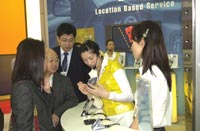 Demonstrating location-based services at ITU
TELECOM
ASIA
2002
(Hong Kong, China). A number of these services are expected to use Demonstrating location-based services at ITU
TELECOM
ASIA
2002
(Hong Kong, China). A number of these services are expected to use
IMT-2000 systems
ITU 026120/A. de Ferron
|
The majority of countries in the world have yet to license or
deploy 3G networks. The contrast is even starker between developed and
developing nations. Countries that have not yet licensed IMT-2000 networks have
several options, based on the benefit of hindsight. One is that there may be no
hurry to license 3G. The first W-CDMA 3G networks have only recently been
deployed at great cost — and all in developed nations. At this point in time, it
may prove difficult for many developing countries to find investors willing to
invest in a brand new 3G network. Instead, countries might consider upgrades to
existing networks, evolving them to 2.5G as a first step to 3G. For GSM
networks, this means the deployment of GPRS while for cdmaOne networks it
involves the installation of CDMA2000 1X. This would provide faster speeds and
greater functionality for the development of mobile data services. If these
upgrades do not require changes to existing frequency allocations, then it may
be wise to encourage such enhancements without requiring a new licence. If
additional spectrum is required within the same frequency, regulators should be
encouraged to act favourably upon this request in the light of the benefits such
spectrum could bring. If new 2G mobile licences are to be issued, then the
authorities may wish to encourage operators to install their networks as
2.5G-ready.
| Contributed by Michael Minges and Pratikshya Simkhada of the “Market,
Economics and Finance Unit” of the ITU Telecommunication Development Bureau (BDT).
This Unit was formerly called “Telecommunication Data and Statistics Unit.” |
|



 A dual-band mobile phone of 1999. Its simple menu
and large display appealed to first-timers, especially youth. With the
young target group came music too
A dual-band mobile phone of 1999. Its simple menu
and large display appealed to first-timers, especially youth. With the
young target group came music too




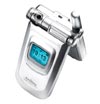

 Demonstrating location-based services at ITU
TELECOM
ASIA
2002
(Hong Kong, China). A number of these services are expected to use
Demonstrating location-based services at ITU
TELECOM
ASIA
2002
(Hong Kong, China). A number of these services are expected to use